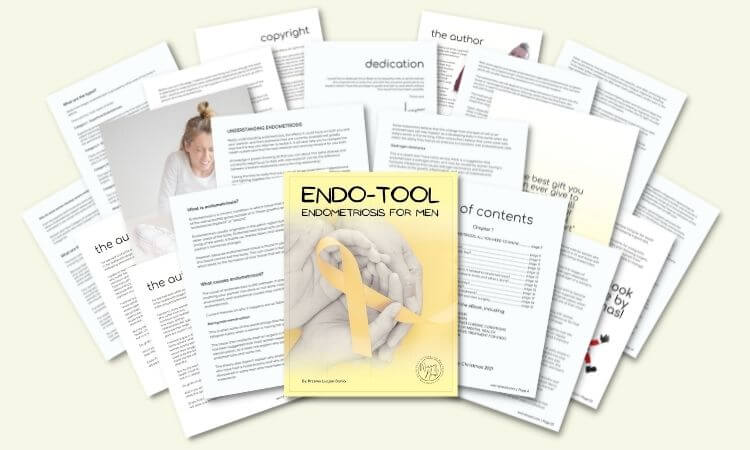How to explain endometriosis to my husband?
How to explain endometriosis to my husband who never experienced what I’m going through? I heard that many times and I can openly say, that being the husband of a woman who suffers from endometriosis, I could barely spell the word, let alone understand it.
So there is no shame because explaining endometriosis to the husband can be challenging. In order to help you do it, I wrote this article, so you don’t have to stress yourself over-explaining endometriosis to your husband.
Explaining endometriosis…
Before I provide you with my tips on how to explain endometriosis to your husband, we need to explain the basics to those who don’t know them, these include questions such as:
- What is endometriosis?
- How do you get endometriosis?
- What are the symptoms of endometriosis?
- How is endometriosis diagnosed?
- What are the treatments for endometriosis?
What is endometriosis?
Endometriosis is a condition characterized by the presence of endometrial-like tissue outside of the uterus. This tissue grows and bleeds in response to the hormonal changes of the menstrual cycle, just as the endometrium does inside the uterus.
However, because this tissue is located outside of the uterus, the blood has nowhere to exit the body and becomes trapped. This can cause inflammation, pain, and the formation of scar tissue.
In severe cases, it can lead to infertility.
If you want to learn everything in terms of endometriosis, from all the medical knowledge to how to cope, support, and thrive in a relationship with someone who suffers from this brutal condition, I give away a FREE Chapter of “Endo-Tool: Endometriosis for Men” eBook.
This chapter alone includes all the comprehensive medical knowledge, such as:
- What is endometriosis?
- What are the symptoms?
- What causes endometriosis?
- What does endometriosis look like?
- What are the stages?
- What are the types?
- What is adenomyosis and how is it related to endometriosis?
- Why do some women develop severe endo and others don’t?
- Does endometriosis cause infertility?
- How is endometriosis diagnosed?
- Do types and stages affect the treatment?
- Recurrence of endometriosis after excision surgery.
FREE Chapter of “Endo-Tool”!
an Endometriosis for Men book

How do you get endometriosis?
While the exact cause of endometriosis is unknown, it is thought to be due to a combination of genetic and hormonal factors. It is estimated to affect between 6-10% of women of childbearing age. There are many theories about how you develop endometriosis, but the most likely explanation is that it is due to a combination of genetic and hormonal factors.
The gene that is connected to endometriosis is called NPSR1. This gene is involved in the development of the endometrium, and women with endometriosis are more likely to have a mutation in this gene.
The hormonal theory of the development of endometriosis is based on the fact that this condition is more common in women who have a history of early menarche (the onset of menstruation), late menopause, and long menstrual cycles. These factors all increase the amount of time that a woman is exposed to estrogen, which is thought to play a role in the development of endometriosis.
What are the symptoms of endometriosis?
The most common symptom of endometriosis is pelvic pain, which can range from mild to severe. The pain is often worse during your period, and it may be difficult to get pregnant if you have endometriosis.
There is a number of symptoms that endometriosis can cause, which can make life very difficult for those who suffer from the condition. The most common symptoms include:
- Painful periods (dysmenorrhea): This is the most common symptom of endometriosis. The pain can range from mild to severe and is often worse during menstruation. It can also be constant, or come and go throughout the month.
- Pain with intercourse: This is another common symptom, and can make sex very painful.
- Painful urination or bowel movements: This can happen if the endometriosis lesions are near the bladder or rectum.
- Excessive bleeding: Some women with endometriosis find that their periods are much heavier than usual and that they bleed between periods.
- Infertility: Endometriosis is one of the most common causes of infertility. It can block the fallopian tubes, or damage the ovaries or uterus, making it difficult for a woman to get pregnant.
If you are concerned that you may have endometriosis, or if you are experiencing any of the symptoms listed above, please make an appointment to see your doctor.
How is endometriosis diagnosed?
Endometriosis diagnosis takes on average between 7 and 10 years. In fact, endometriosis is one of the most underdiagnosed and misdiagnosed conditions, with many women being told that their symptoms are “all in their head” or that they just have to “tough it out.”
If you think you may have endometriosis, see your doctor and be persistent about getting a diagnosis. It can be difficult to diagnose endometriosis, as symptoms can vary greatly from woman to woman and some women may not have any symptoms at all.
There is no definitive test for endometriosis, but your doctor may start with a pelvic exam. They may also order ultrasounds, MRI scans, or laparoscopy (a minimally invasive surgery) to confirm the diagnosis.
Once you have a confirmed diagnosis of endometriosis, you and your doctor can work together to develop a treatment plan.
What are the treatments for endometriosis?
If you are diagnosed with endometriosis, there are a number of treatment options available. These include medication, surgery, and lifestyle changes. The type of treatment that is right for you will depend on the severity of your symptoms and your overall health.
To treat this chronic condition with surgery, you need to know what kinds of endometriosis surgery types are there. They include:
- Laparoscopic surgery: A surgeon makes small incisions in your lower abdomen and inserts a thin, lighted tube called a laparoscope. The laparoscope allows the surgeon to see and remove endometrial tissue.
- Laser surgery: A surgeon uses a laser to vaporize endometrial tissue.
- Electrocautery: A surgeon uses an electric current to destroy endometrial tissue.
- Hysterectomy: This is the last resort and is only recommended if you have severe endometriosis and other treatments haven’t worked. In a hysterectomy, the surgeon removes your uterus.
Your doctor may also recommend medication to treat endometriosis, such as:
- Pain relievers: Over-the-counter pain relievers, such as ibuprofen, may help reduce pain associated with endometriosis.
- Hormone therapy: This can help reduce the size of endometrial tissue growth and relieve pain.
- Gonadotropin-releasing hormone agonists (GnRH agonists): These drugs work by temporarily stopping ovulation and can help relieve pain associated with endometriosis.
In addition to medical treatment, there are a number of lifestyle changes you can make to help ease endometriosis symptoms. These include:
- Exercise: Regular exercise can help reduce pain associated with endometriosis.
- Stress reduction: Stress can make endometriosis symptoms worse. Finding ways to reduce stress, such as through yoga or meditation, may help relieve symptoms.
- Diet: Some women find that certain foods, such as coffee, alcohol, and red meat, can make endometriosis symptoms worse. Avoiding these foods or eating them in moderation may help reduce symptoms.
Endometriosis can be a difficult condition to deal with, but you don’t have to go through it alone. Talk to your doctor about your symptoms and treatment options.

How to explain endometriosis to my husband?
Okay, housekeeping is done. Now that we know the basics, let’s move on to how you can explain endometriosis to your husband…
Endometriosis is a tricky condition to explain for someone who is never going to experience what you feel because it isn’t well understood even by general practitioners.
In short, tell your husband that endometriosis is a chronic condition characterized by the presence of tissue that is similar to the one that lines your uterus and grows outside the uterus. This abnormal tissue growth can cause you a lot of pain, heavy bleeding, and other symptoms.
Explain to your husband that there is no cure for endometriosis and that in the future you may or may not have to go through more surgeries to remove the endometrial tissue, but it all varies from person to person, and it’s unpredictable.
Help him understand that the unpredictability of how you feel from day to day is a new normal.
Normally, that should be enough for him to understand, you didn’t overcomplicate it, and you gave him the general idea. But, some men like to know more, they want details so they can understand better what their wives are dealing with on a daily basis.
If that’s the case with your husband, then you can tell him that doctors don’t know exactly what causes endometriosis, there are theories, but so far, that is all they know. There is no cure for endometriosis, but treatments can help you manage your symptoms.
Explain, that for some women with endometriosis, the pain is constant and can be quite debilitating, but for other women this pain is sharp, stabbing, sudden, and short-term. Chronic fatigue is also a common symptom, making it hard to get through the day or even get a good night’s sleep. These symptoms can make it hard to keep up with work, family, and social obligations.
Explaining endometriosis to the husband can be hard.
If you’re trying to explain endometriosis to your husband, it’s important to be patient and understand that he may not fully grasp what you’re going through.
Explaining endometriosis to your husband, but can be helpful to talk about how the condition has affected your life and how it causes you pain and fatigue. You may also want to share information about endometriosis from reputable sources, such as this one or the blog you are reading right now.
It’s also important to remember that everyone experiences endometriosis differently. What works for one person may not work for another. Because you are a team, don’t hesitate to ask for understanding and support from your husband as you both navigate this condition.
One of the symptoms that some women experience, including my wife, is brain fog, but we talk about it later. Firstly, in the next paragraph, I give you an answer to the question of how to explain endometriosis pain to your husband.
How to explain endometriosis pain to your husband?
Endometriosis has many types of pain, which can depend on where the endometriosis lesions are located. The pain can also vary in intensity and duration. This seems like a basic explanation, and the simpler the better. But if he wants to learn more, the best way to explain the pain of endometriosis to your husband is to be as specific as possible.
Endometriosis pain can be caused by the inflammation of endometrial tissue, as well as by the formation of scar tissue and adhesions. The pain can also be caused by the stretching of the pelvic cavity, as the endometrial tissue grows.
The most common type of pain is pelvic pain. This can feel like a dull ache in the lower back and pelvis, or it can be sharp and crampy, like menstrual cramps. The pain can be intermittent or constant, and it may worsen during your period.
Even though endometriosis pain can originate in either the pelvic area, ovaries, or anywhere central, it can spread to the legs, back, or even the belly button area. So when you’re trying to explain endometriosis pain to your husband, it’s important to be as specific as possible about where you feel the pain and how it feels.
Even though he never experienced a period in his life, he might have heard about it, so it could be a good idea to explain to your husband the difference between endometriosis pain and menstrual cramps.
For some women, the pain of endometriosis is mild and feels like menstrual cramps. But for other women, the pain is much more severe.
Endometriosis pain can vary from person to person, and even from day to day. For some people, the pain is mild and manageable. But for others, the pain can be severe and debilitating.
Describe where you feel pain, how often it occurs, how long it lasts, and how severe it is. You might also want to share how the pain affects your life, such as making it hard to get a good night’s sleep or preventing you from participating in activities you enjoy.
It can also be helpful to explain that there is no cure for endometriosis and that treatments aim to manage symptoms. You may want to share information about treatment options with your husband, such as pain relievers, antidepressants, and exercise.
How to explain brain fog to your husband?
How to explain brain fog to your husband that is associated with endometriosis? In short, brain fog can be described as a feeling of confusion, forgetfulness, and general mental fatigue. It can feel like your head is in a fog and you can’t think clearly.
Brain fog is a common symptom of many conditions, including depression, anxiety, sleep deprivation, chronic fatigue syndrome, and fibromyalgia. It can also be a side effect of certain medications.
There are many potential causes of brain fog, including dehydration, poor nutrition, lack of sleep, and hormonal imbalances. Additionally, certain medical conditions can also lead to feelings of mental fatigue and confusion.
FREE Chapter of “Endo-Tool”!
an Endometriosis for Men book

17 tips on explaining endometriosis to a husband.
To summarise this article, I listed below 17 tips on explaining endometriosis to your husband:
- Be as specific as possible when describing the pain.
- Explain that endometriosis pain can vary from person to person.
- Describe how the pain affects your life.
- Share that there is no cure for endometriosis, but treatments can help manage symptoms.
- List some potential causes of brain fog, including hormonal imbalances and chronic fatigue syndrome.
- Let him know that you may need to make lifestyle changes to manage your symptoms, such as getting more sleep or exercising more often.
- Reassure him that you’re still the same person despite having endometriosis.
- Explain that endometriosis is a common condition that affects millions of women worldwide.
- Describe the different types of treatment available for endometriosis, such as pain medication and surgery.
- Share that you’re working with a healthcare team to manage your condition and find the best treatment for you.
- Ask him to be understanding and supportive as you go through this journey.
- Let him know that he can’t catch endometriosis from you.
- Explain that there is currently no cure for endometriosis, but treatments can help improve symptoms.
- Share that you may need to make some lifestyle changes, such as exercise and stress reduction, to help manage your symptoms.
- Reassure him that you’re still the same person despite having endometriosis.
- Thank him for his support and understanding during this time.
- Let him know that you’re not alone in this and that there are millions of other women worldwide who are affected by endometriosis.
I hope this article helped you explain endometriosis to your husband. If you have any tips of your own, please share them in the comments below.


About Me
Hi, I’m Lucjan! The reason why I decided to create this blog was my beautiful wife, who experienced a lot of pain in life, but also the lack of information about endometriosis and fibromyalgia for men…
